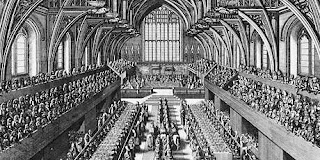Victoria here, reporting on a meeting I attended recently at Chicago's Newberry Library. Cosponsored by the Royal Oak Foundation, the U.S. support group for Britain's National Trust, and Historic Royal Palaces Inc., I met my pal Susan Forgue to hear Suzanne Groom speak about her new book, At the King's Table.
In addition to many other activities, the Royal Oak Foundation brings speakers to various cities around the U.S. for fascinating illustrated lectures. To learn more about the Royal Oak Foundation, click here. Historic Royal Palaces website is here. And, to complete the picture, click here for the Newberry Library website.
Suzanne Groom, author of At the King's Table
The Newberry Library in October
Ms. Groom spent 25 years with Historic Royal Palaces, working at projects at Hampton Court, the Banqueting House and Kew Palace. Her account, beautifully illustrated, of the feasts held by the Kings of England, goes back to William the Conqueror. I cannot begin to reproduce all her fascinating stories of Royal Banquets, but I can recount a few. You will find much, much more in the book.
The Field of Cloth of Gold,
1774 Print by James Basire from a 16th-century painting in the Royal Collection
In June of 1520, two young kings, accompanied by their queens, large retinues of knights and retainers and hundreds of servants, met for a conference, jousting and games, music and dancing, and an unprecedented effort to out-impress one another with their sumptuous banquets and extravagant arrangements. Henry VIII and François I of France met at the Field of Cloth of Gold in France, for weeks of celebration of the recent treaty of friendship between the two traditional enemy nations. Despite the fine cuisine and the jolly time for all of those above the scullery help, the friendship was enmity again within a few years. The name of the event grew out of the lavish use for tents, furnishing, and attire of cloth woven with gold thread.
Charles II knighting the beef: Sir Loin
An old tale that is difficult to verify tells of a monarch -- in various versions Henry VIII, Elizabeth I, James I, or Charles II -- who drew a sword and knighted a delicious cut of beef. "Arise, Sir Loin," the monarch supposedly said, and thus the finest cuts of beef are so named. True or not, it is an amusing story.
Coronation Banquet for James II
A story that is substantiated in many accounts is the coronation banquet of James II (1633-1701), held in Westminster Hall, April 23, 1685. It began at 11:30 am with the arrival of the King and Queen, but other participants had to be in place much earlier. Royalty departed at 7 pm, after the diners had been served 1,145 dishes, including many cuts of meat, sweetmeats, jellies and blancmange. James II did not last long as king; he was replaced in the Glorious Revolution of 1688 by William III of Orange and his Queen, James's daughter Mary.
King's Eating Room, Hampton Court Palace
William and Mary added on to Hampton Court Palace, and the King's Eating Room is now available for you to hire for your own soiree, if you so desire.
As the website says, "It seems an odd idea to us now, but if you visited court in the 18th century one of the highlights would be watching the king eating his dinner. Anyone respectable enough and well-dressed enough (ie, wearing their coat, wig, sword….) would be admitted to see the sight, which took place several times a month. During public dining, King William III or King George II would not sit down to eat with their friends, but would be served in solitary splendour at a table in this room, with the crowds of spectators respectfully standing back." For more information, click here.
Coronation Banquet of George IV, 1821
.
A Voluptuary under the horrors of Digestion, James Gillray, 1792
British Museum
Soon, an account of an exhibition at the Newberry Library concerning the American Civil War -- including the role of Great Britain


















No comments:
Post a Comment